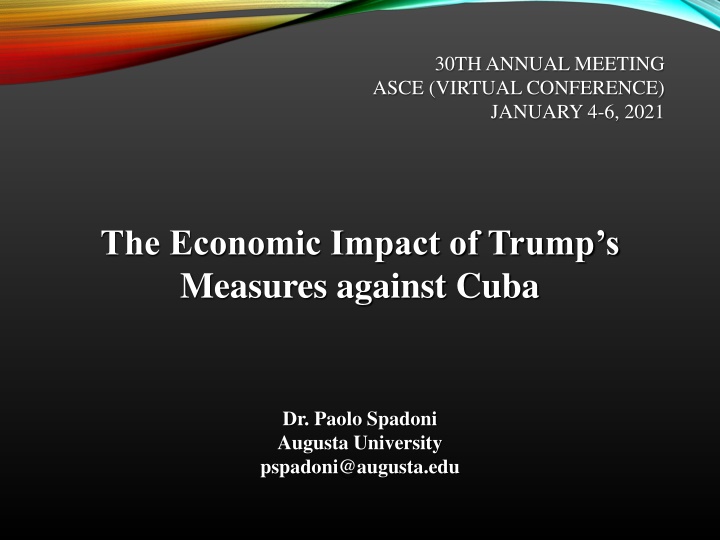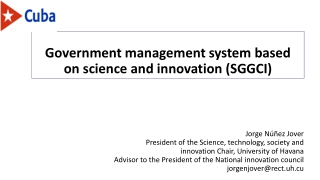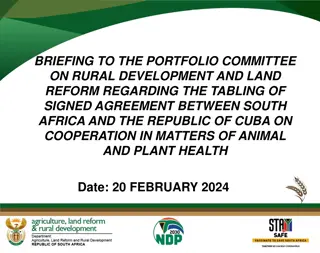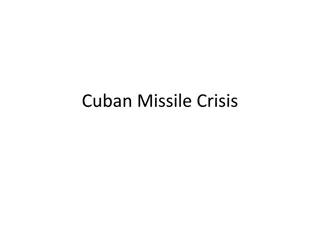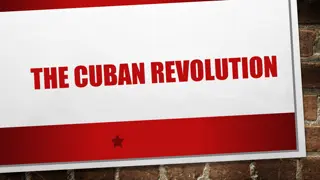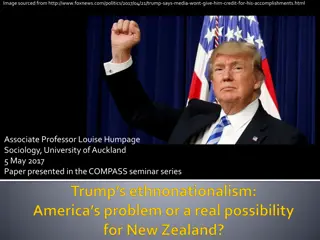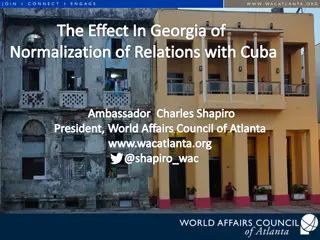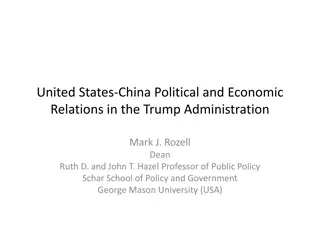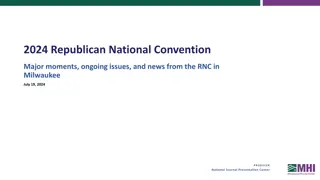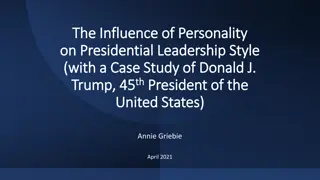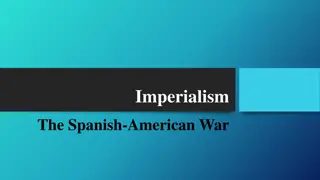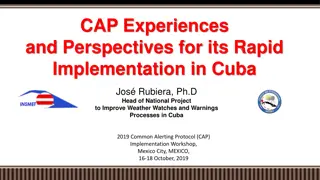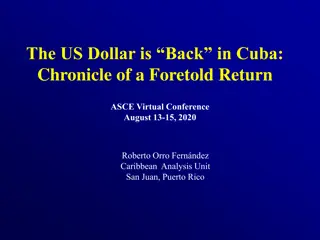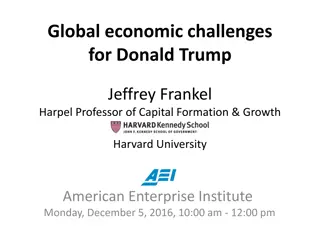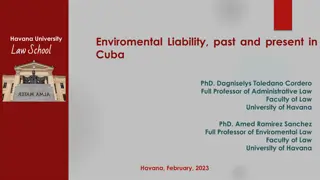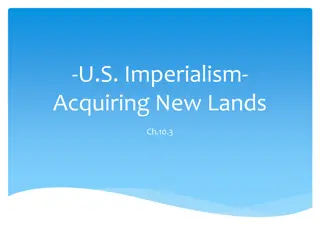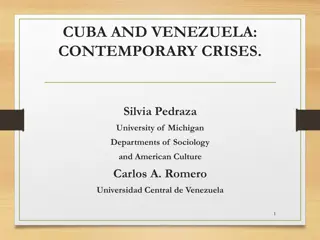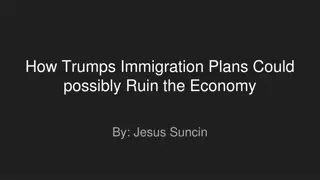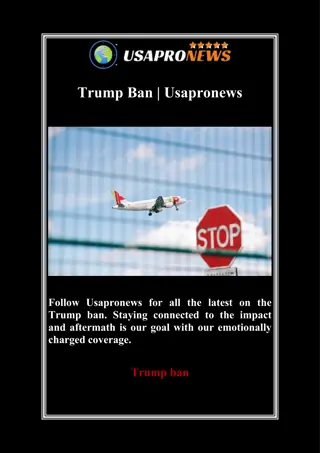Economic Impact of Trump's Measures on Cuba
This presentation explores the economic impact of Trump's measures against Cuba, including a review of Obama's previous actions, the effects of Trump's measures since November 2017, and additional factors influencing the Cuban economy.
Download Presentation

Please find below an Image/Link to download the presentation.
The content on the website is provided AS IS for your information and personal use only. It may not be sold, licensed, or shared on other websites without obtaining consent from the author.If you encounter any issues during the download, it is possible that the publisher has removed the file from their server.
You are allowed to download the files provided on this website for personal or commercial use, subject to the condition that they are used lawfully. All files are the property of their respective owners.
The content on the website is provided AS IS for your information and personal use only. It may not be sold, licensed, or shared on other websites without obtaining consent from the author.
E N D
Presentation Transcript
30TH ANNUAL MEETING ASCE (VIRTUAL CONFERENCE) JANUARY 4-6, 2021 The Economic Impact of Trump s Measures against Cuba Dr. Paolo Spadoni Augusta University pspadoni@augusta.edu
INTRODUCTION Trump in June 2017 Said Obama had negotiated terrible and misguided deal with Cuba "Effective immediately, I am canceling the last administration s completely one-sided deal with Cuba." Promised to enforce tourism ban and embargo, help Cuban private sector, restrict dollars to Cuban military (first changes in Nov 2017) Structure of the presentation Brief review of Obama s measures and their effects Trump s measures on Cuba since November 2017 Economic impact of Trump s measures Additional factors impacting Cuban economy Concluding observations
OBAMAS MEASURES ON CUBA Issued six sets of amendments to sanctions rules after 17D Key changes Independent travel to Cuba under general license (12 categories, no tourism) Direct commercial flights, cruises, ferry services No limits on remittances US telecom firms can have JVs in Cuba Trade with Cuban private sector (cuentapropistas and coops) US financial institutions can open correspondent accounts at Cuban banks, process U-turn transactions linked to Cuba Cash in advance (agricultural exports) from cash before shipment to cash before transfer of title Modification of 180-day ship rule
ECONOMIC EFFECTS OF OBAMAS MEASURES Travel and tourism industry Significant, over 600,000 U.S. visitors (non-Cuban) to Cuba in 2017 Resumption of cruise trips in May 2016 Higher revenues for Cuban government and private entrepreneurs Investment Cuba more appealing investment market Several U.S. business deals with Cuba (esp. travel/tourism, telecom) Yet initial wave of enthusiasm gave way to more cautious approach Other areas Remittances up, especially to set up small private businesses Cuba s external debt eased, new credit lines, but still liquidity problems Slow progress in trade
U.S. VISITORS TO CUBA, 2009-2017 Sources: Perell Cabrera 2018; ONEI 2018. Visits by U.S. citizens of non-Cuban origin grew almost seven-fold in 2014-2017 Cuban American visitors grew less because restrictions lifted in 2009 Over 1 million U.S. visitors to Cuba in 2017
VISITOR DAYS BY SECTOR, 2014-2017 Source: MINTUR 2018. Visitor days: combination of number of visitors and length of stay Proportion state vs. private sector 4:1 in 2014, less than 2:1 in 2017 ONEI: revenues of private sector nearly doubled in 2014-2017
TRUMPS MEASURES ON CUBA Issued eight sets of amendments to sanctions rules Nov. 2017: people-to-people group travel, no business with GAESA firms May 2019: activated Title III of Helms-Burton June 2019: ended people-to-people travel, banned cruise ships to Cuba Sept. 2019: limited family remittances ($1,000 per quarter), no U-turn trans. Oct. 2019: revoked licenses for aircraft leases to Cuba, 10% de minimis for re-exports, suspended commercial flights to all Cuban cities except Havana Jan 2020: suspended all U.S. to Cuba private charter flights except Havana Aug 2020: suspended all U.S. to Cuba private charter flights Sept 2020: banned U.S. citizens from staying at over 400 state-owned hotels in Cuba and from bringing back Cuban rum and cigars
TRUMPS MEASURES ON CUBA (CONT.) List of Restricted [Cuban] Entities (last update Jan 2021) No direct financial transactions with hundreds of Cuban entities Recent additions: Fincimex + American International Services (remittances Sept 2020) Banco Financiero Internacional (BFI Jan 2021) Venezuela/Cuba Sanctions on Venezuela s petroleum industry and on tankers transporting Venezuelan oil to Cuba Sanctions on foreign banks doing business with Cuba Ordered Marriott to cease hotel activities in Cuba (June 2020) Forced Western Union to end remittance services (Nov 2020)
ECONOMIC IMPACT OF TRUMPS MEASURES Travel and tourism industry Major reduction of visitor flows to Cuba Less revenues for Cuban government but especially for private sector Investment (Helms-Burton law) 26 Title III lawsuits in first year fewer than expected with 76 companies named as defendants (50 U.S., 26 European firms) H-B lawsuit against Carnival dismissed in July 2020 But some potential foreign investors in Cuba deterred (airport/railways upgrades, hotels construction, gold courses, others) Other areas Remittances probably down (esp. in 2020 also because of COVID-19) Hindered Cuba s ability to complete transactions with foreign banks ($12 billion total fines on numerous banks by March 2020), obtain external credit Disrupted Venezuela s oil supplies to Cuba (unreliable)
U.S. VISITORS BY MODE OF TRANSPORTATION, 2014-2019 (EXCLUDES CUBAN AMERICANS) Source: MINTUR 2020. 2017-2019: U.S. visitors -20% (air -33%) full impact not seen at end of 2019 Cuban American visitors +28% during same period (about 553,000 in 2019)
TOURISM-RELATED REVENUES OF CUBA'S PRIVATE SECTOR, 2014-2019 Source: ONEI 2020. 2017-2019: Cuba s total tourism revenues 20% Revenues of private sector 47% during same period
FOREIGN DIRECT INVESTMENT IN CUBA, 2014-2020 Sources: EIU 2020, 2019. Cuba govt: 180 projects worth $7.4 billion approved 2014-2020 (more in Mariel) This refers to value of deals agreed (Cuba seeks $2-2.5 billion FDI per year) EIU: average annual FDI was $676 million in 2014-2020 (below targets)
ADDITIONAL FACTORS Triple punch: Venezuelan crisis, Trump, coronavirus Venezuela s economic (and political) crisis Reduced Venezuelan oil shipments to Cuba, exports of Cuban professional services to Venezuela, bilateral merchandise trade Coronavirus pandemic Halted tourism, disrupted informal remittance channels, increased shipping costs, exacerbated food shortages Reduced hard currency revenues, financial flows (yet opportunities with medical missions abroad)
CUBA'S MAIN SOURCES OF HARD CURRENCY, 2014-2020 Sources: ONEI 2020, 2019; MEP 2020; Morales 2020, 2019. *Estimates for 2020. Cuba s total hard currency revenues -30% in 2020 from 2019 (-50% from 2014) Cuba s GDP -11% in 2020 (-0.2% in 2019) structural reforms needed
CONCLUSION Trump kept his promise to reverse Obama s Cuba policy His measures had significant negative effects on Cuba (travel, investments, formal and informal remittances, oil supplies, banking operations) Possible reinstatement of Cuba on U.S. list of state sponsors of terrorism Cuba at the end of 2020 Very precarious economic situation Venezuelan crisis, Trump s measures, COVID-19, systemic problems Prospects for 2021 Trump on his way out Cuba announced critical economic reforms but unclear when and how they will be implemented Also to be seen what new Biden administration will do with Cuba
